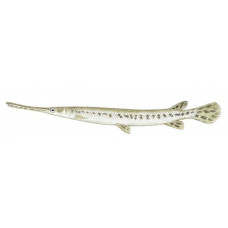Latin name
Lepisosteus osseus
Other names
French: garpique longnez; Spanish: gaspar picudo.
Identification
The body of the Long-billed Gar is long and slender. It has an elongated narrow bill (length 18-20 times the width at the narrowest point). The skeleton is partly cartilage and partly bone. Both the upper and lower jaws are covered with strong, sharp teeth. The nostrils are located in a small, bulbous, fleshy projection at the tip of the beak. The body is covered with bony, ganoid (rhomboid) scales. The dorsal and anal fins are set well back. The coloration is olive brown or dark green along the back and upper flanks, with a silvery white belly. There are numerous black spots on the body, but not on the head or jaws. Longnose gar can be distinguished from other gar by its elongated snout.
Distribution
Longnose gar are the most common and widespread of all gar. It is found primarily in the eastern half of North America, in the Mississippi River system and other waterways. Its range generally extends from Minnesota and the Great Lakes to Quebec, south to southern Florida and the Gulf States, and west to the Rio Grande, bordering Texas and Mexico. It can reach as far north as Montana and as far south as the Pecos River in New Mexico. Large populations are found along the Atlantic coast.
Habitat
Longnose gar live in warm, still water, often inhabiting shallow weedy areas and sluggish pools, backwaters, and tributaries of large and medium-sized rivers and lakes. They sometimes enter brackish water and can tolerate murky and stagnant environments.
Size
The average length of the fish is 2-3 feet, but sometimes up to 5 feet. The record for all tackle is 50 pounds, 5 ounces.
Life history and Behavior
Groups of adult gar often lie motionless near the surface, resembling floating sticks. In summer, they turn over and float to the surface to take in air (usually in very murky water) and release gases from their air bladders. Males become sexually mature at 3-4 years, females at 6 years. Spawning occurs in spring in shallow water.
Food and feeding habits
Longnose gar feed on shiners, sunfish, gizzard shad, catfish, and bullheads. Sometimes they will chase their prey slowly, but more often they have been known to lie down and wait for it to approach.
Reproduction
No information
| Classification | |
| Phylum | Chordata |
| Class | Actinopterygii |
| Squad | Lepisosteiformes |
| Family | Lepisosteidae |
| Genus | Lepisosteus |
| Species | L. osseus |
| Features | |
| Conservation status | Least Concern |
| Habitat | Pelagic |
| Life span, years | 39 |
| Maximum body weight, kg | 25 |
| Maximum length, cm | 122 |
| Sailing speed, m/s | No information |
| Threat to people | Edible |
| Way of eating | Predator |



